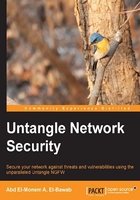
What this book covers
Chapter 1, Introduction to Untangle, introduces you to the world of information security and Untangle. This book starts by giving a brief introduction about Untangle, the company. Then, it provides some information about security concepts. After that, it gives a detailed introduction to Untangle NGFW.
Chapter 2, Installing Untangle, guides you on how to build and install the Untangle NGFW server. This chapter first discusses the hardware requirements of Untangle NGFW. Then, it describes the virtualized environment used for this book's examples. Next, the chapter covers how to obtain Untangle installation media, and then it guides you through a step-by-step installation of Untangle NGFW.
Chapter 3, The Initial Configuration of Untangle, walks you through the initial configuration wizard of Untangle NGFW in which we configure the administrator account, interfaces' IPs, and Untangle mode. In addition, it explains the GUI of Untangle NGFW.
Chapter 4, Untangle Advanced Configuration, covers how to configure network-related settings such as interface IP, VLAN, DHCP, DNS, QoS, Routes, NAT, and port forwarding. Also, it discusses Untangle's high availability options.
Chapter 5, Advanced Administration Settings, covers the settings related to Untangle NGFW administration such as the administrators' accounts, Untangle public address, backup and restore, and the e-mail settings for Untangle NGFW to send e-mails to users.
Chapter 6, Untangle Blockers, covers the Untangle applications that protect your network from direct threats such as viruses, spam, phishing, and malicious traffic.
Chapter 7, Preventing External Attacks, covers how you can protect your network from the Denial of Service (DoS) attacks by using intrusion prevention systems to stop malicious traffic and using firewall to limit the number of opened ports.
Chapter 8, Untangle Filters, covers Untangle applications that improve the user's productivity and network performance by blocking access to least important sites such as social networks, and denying traffic from applications such as BitTorrent. In addition, this chapter covers how Untangle NGFW can scan and filter the HTTPS traffic.
Chapter 9, Optimizing Network Traffic, covers how you can save and optimize your WAN bandwidth by limiting nonbusiness-related applications and prioritizing business-related applications. In addition, this chapter will also cover the use of Web Cache to enhance users' browsing experience.
Chapter 10, Untangle Network Policy, shows how it's possible to set access rules based on the Active Directory user and group membership, and how to force users to accept the acceptable use policy before they start using your network resource.
Chapter 11, Untangle WAN Services, describes the Untangle NGFW modules that allow for using WAN services from multiple ISPs to provide higher throughput and a continuous WAN connection to users even if any of the connection has failed.
Chapter 12, Untangle VPN Services, covers the modules that allow Untangle NGFW to provide a VPN connection to its remote users or between two branches.
Chapter 13, Untangle Administrative Services, shows how administrators can simplify their tasks using reporting, automated backups, and premium support, and how they can customize Untangle logos, interfaces, and pages.
Chapter 14, Untangle in the Real World, provides a brief overview of the regulatory compliance related to the IT field. Then, it lists the Untangle NGFW advantages over its rivals. Finally, it provides some examples on how Untangle is used in the small and medium businesses, education, healthcare, government, and nonprofit sectors.